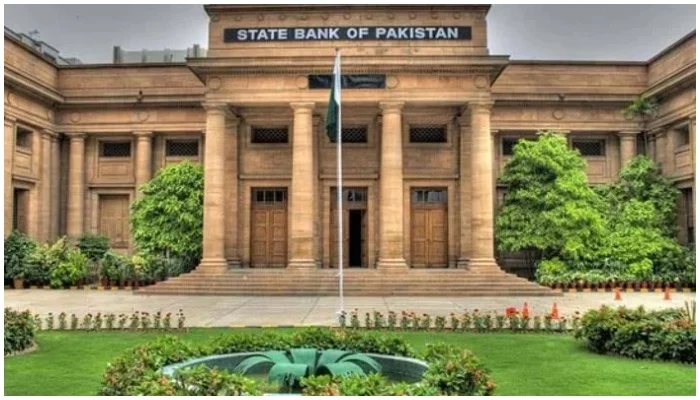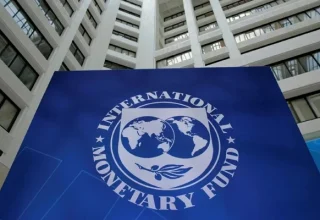KARACHI (Dunya News) – Due to strong economic expansion, financial sector of Pakistan manifested steady performance in CY21 while its financial and operational resilience remained intact, the State Bank of Pakistan (SBP)’s annual flagship publication, the Financial Stability Review (FSR) for CY21 said.
The financial sector’s asset base expanded by 15.6 percent in CY21, while financial markets observed a relatively contained volatility compared to last year.
The review presents the performance and risk assessment of various segments of the financial sector including banks, non-bank financial institutions, financial markets, financial market infrastructures and non-financial corporates.
The assessment of global dynamics highlights that due to the better management of pandemic and an extensive vaccine inoculation drive, the ensuing recovery in world economic activity that started in second half of CY20 got further traction in CY21. However, supply chain disruptions fueled inflationary pressures and the recurring waves of new COVID-19 variants continued to pose challenges to the global economic activity and financial markets.
The review highlights that the domestic economy navigated through two COVID-19 waves during CY21 without significant impact due to effective management of the pandemic, which facilitated a strong revival in economic activity. The GDP grew by 5.7 percent in FY21 (against 1.0 percent contraction in FY20), and the momentum got further traction in FY22 to post an estimated growth of 6.0 percent. However, the robust recovery in demand and rising international commodity prices, especially oil, led to external account pressures. Accordingly, SBP took a number of macro-prudential and monetary policy measures to stabilize the external account, moderate the domestic demand and address associated risks.
In the context of strong economic expansion, financial sector manifested steady performance while its financial and operational resilience remained intact. The financial sector’s asset base expanded by 15.6 percent in CY21, while financial markets observed a relatively contained volatility compared to last year.
The FSR indicates that the banking sector— the major part of the financial system—posted a strong growth of 19.6 percent (CY20: 14.2 percent), which was particularly aided by a surge in private sector advances. The expansion was well supported by healthy deposits growth of 17.3 percent, while banks also increased reliance on borrowing from the banking system. Encouragingly, credit risk of the banking sector remained contained as gross NPLs ratio declined by 130 bps to 7.9 percent, while provisions coverage ratio improved by 291 bps to 91.2 percent.
Accordingly, net NPLs ratio declined to 0.7 percent, indicating lower residual risk to the solvency from delinquent loans. On the performance front, the earning indicators observed improvement as ROA stood at 1.0 percent and ROE improved to 14.1 percent. Due, in part, to the improved earnings, banks’ solvency remained strong as reflected in the high Capital Adequacy Ratio of 16.7 percent that stayed well above the minimum domestic regulatory benchmark of 11.5 percent and international benchmark of 10.5 percent.
The Islamic banking segment also posted strong performance with a 30.6 percent increase in its asset base during CY21, extending their share by 160 bps to 18.6 percent in the banking sector. Microfinance Banks, which exhibited a reasonable growth, observed an inch up in infection rate and deterioration in earning indicators.
From the demand side perspective, the FSR reveals that Non-Financial Corporate sector showed a marked improvement in profitability, business turnover, efficiency and debt repayment capacity. While this improvement bodes well for credit risk of the financial system, it also signifies a likely boost in the corporate sector’s demand for financial products and services.
The report notes that Financial Market Infrastructures (FMIs) remained resilient and continued to perform efficiently without any major disruption. SBP launched Pakistan’s Instant Payment System, Raast, which marked a major step towards implementing the National Payment Systems Strategy.
Since the launch of its P2P component in February, 2022, the number of Raast IDs registration surpassed the 10 million mark, with aggregated value of transaction crossing PKR 36 billion.
Similarly, the Roshan Digital Account initiative, which was introduced in late CY20 to provide a convenient way of digital banking services to Pakistani Diaspora, crossed 416 thousand accounts with a cumulative inflow of over USD 4.4 billion by End-May 2022.
Likewise, a comprehensive Customers’ Digital Onboarding Framework has been introduced to allow resident Pakistanis to remotely open bank accounts. Such initiatives are also expected to play a key role in enhancing financial inclusion in the country. To cater to cyber security risk, which is mainly associated with increasing use of technology and evolving digital payment landscape, SBP took various measures during the year to enhance industry’s resilience against the risk.
The review also highlights various measures taken by SBP during the year to strengthen the regulatory and supervisory regime, including the introduction of a forward-looking Risk-Based Supervisory framework and lender of last resort (LOLR) facility to enhance its financial safety nets. Importantly, the amended SBP Act 1956 has clearly delineated financial stability as one of the objectives of SBP.
Going forward, risks to financial stability are contingent upon the strength of external buffers, policy continuity, and overall macroeconomic conditions in the context of developments on geo-political front in Europe, global commodity prices and global financial conditions. Stress test results, in the meantime, show that the banking sector is expected to maintain a reasonable resilience against various hypothetical adverse economic shocks over the projection period of three years.
Amid the dynamic and challenging environment both at domestic and global fronts, SBP, on its part, will continue to undertake initiatives to keep pace with the evolving financial landscape and remains vigilant to the emerging risks, while standing ready to take necessary measures in pursuit of its statutory objectives of price stability, financial stability and economic growth.


































